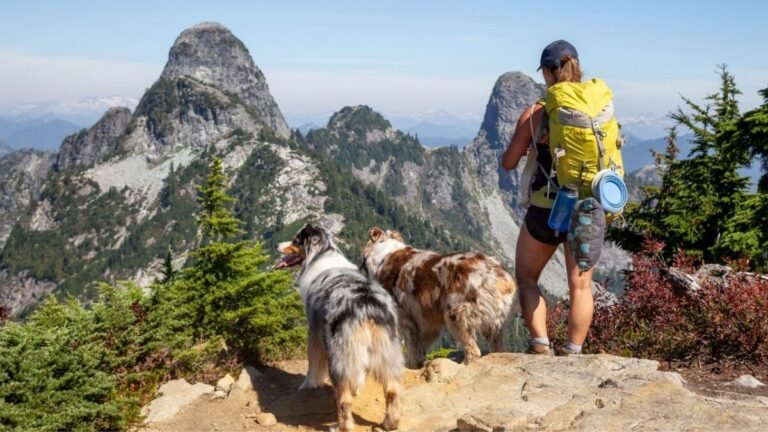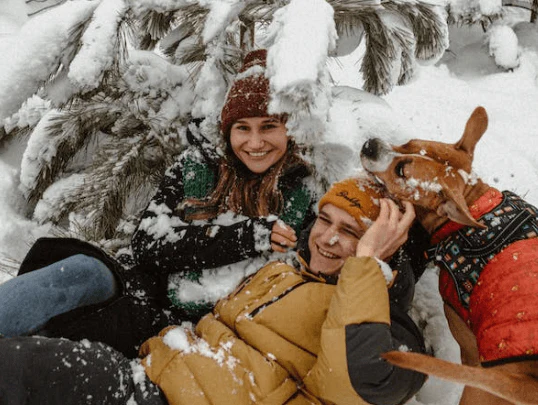Embark on an exciting journey with your adventurous canine companion by learning how to plan the perfect outdoor escape together. From choosing pet-friendly destinations to packing vital supplies, this guide will help you create unforgettable memories while exploring the great outdoors with your furry best friend.
Understanding Your Dog’s Needs
Factors to Consider for a Safe and Enjoyable Trip
Your dog’s safety and well-being should be your top priority when planning an outdoor adventure. Before commenceing on any trip, consider factors such as your dog’s age, breed, physical abilities, and temperament. Make sure to pack necessarys like food, water, a leash, and any medications your dog may need. It’s also important to research the area you’ll be visiting to ensure it’s pet-friendly and safe for your furry companion.
- Take into account your dog’s comfort and familiarity with the outdoors.
- Plan for any potential hazards like extreme weather or rough terrain.
- Ensure your dog is up to date on vaccinations and flea/tick prevention.
Any concerns about your dog’s behavior or health should be addressed by a veterinarian before going on an outdoor adventure.
Assessing Your Dog’s Fitness Level and Health
Even if your dog seems energetic and ready for any adventure, it’s necessary to assess their fitness level and health before planning a trip. Little by little, increase the length and intensity of your walks to gauge your dog’s endurance. Monitor their breathing, limping, or any signs of fatigue during physical activity. Regular check-ups with your vet can help ensure your dog is in good health and able to handle outdoor excursions.
Another aspect to consider is your dog’s age and any pre-existing health conditions they may have. Older dogs or those with medical issues may require special accommodations or shorter, less strenuous hikes to prevent any health complications during the trip.
Identifying Breed-Specific Needs and Limitations
On top of assessing your dog’s overall fitness level, it’s crucial to understand any breed-specific needs and limitations they may have. Different breeds have varying levels of energy, endurance, and tolerance to certain weather conditions. Some breeds are better suited for long hikes, while others may prefer shorter walks or activities that don’t require intense physical exertion. By identifying your dog’s breed characteristics, you can tailor your outdoor adventures to suit their needs.
Consider researching your dog’s breed to learn more about their tendencies, health predispositions, and optimal physical activities. This knowledge will help you plan a safe and enjoyable outdoor escape that caters specifically to your furry companion.
Choosing the Right Destination
Even before packing your bags and grabbing the leash, it’s crucial to choose the right destination for your outdoor adventure with your furry friend. Here are some key considerations to keep in mind when selecting a destination that is perfect for both you and your dog.
Tips for Selecting Dog-Friendly Trails and Parks
- Look for trails and parks that are explicitly marked as dog-friendly to ensure a welcoming environment for your pet.
- Check if the trails allow dogs off-leash or if they require dogs to be on a leash at all times.
Assume that not all trails and parks are suitable for dogs, so it’s crucial to do your research beforehand to avoid any disappointments on the day of your adventure.
Researching Local Regulations and Restrictions
Restrictions on dogs can vary from one location to another, so make sure you are aware of any specific regulations or restrictions in the area you plan to visit. Plus, some parks may have breed-specific bans or limitations on the number of dogs allowed per person, so it’s best to be informed to avoid any issues during your trip.
Considering Weather and Climate Factors
- Check the weather forecast before heading out to ensure you and your dog are prepared for the conditions you may encounter on the trails.
After considering the weather conditions, think about the climate of the destination you are planning to visit. Another important factor to keep in mind is the time of year, as extreme temperatures can be dangerous for your furry companion.
Packing Essentials for a Successful Trip
How to Prepare a Canine First-Aid Kit
All adventurers should prepare for the unexpected, and this includes your four-legged companion. Even if you are careful, accidents can happen. That’s why it’s necessary to pack a first-aid kit specifically for your furry friend. Your canine first-aid kit should include items such as bandages, gauze pads, antiseptic wipes, tweezers, scissors, and any necessary medications your dog may need.
The Importance of Bringing Adequate Food, Water, and Shelter
If you want to have a successful outdoor adventure with your dog, you need to ensure that you have enough food, water, and shelter for both of you. Your dog will need to stay hydrated and energized during your trip, so pack plenty of water and high-quality dog food. Additionally, make sure to have a portable water bowl and enough food for the entire duration of your adventure. Providing adequate shelter, such as a tent or a sleeping bag for your dog, is also crucial to keep your furry friend comfortable and safe.
If you plan on being in remote areas or commenceing on lengthy journeys, it’s even more important to carefully pack and plan for your food, water, and shelter needs. Remote locations may not have easily accessible resources, so you must be self-sufficient. Consider your dog’s dietary needs and pack accordingly to ensure your canine companion remains healthy and happy throughout your adventure.
Must-Have Gear for a Comfortable and Safe Adventure
The key to a successful outdoor escape with your furry friend is having the right gear. Your dog will need a collar with identification, a sturdy leash, and a harness for added safety. You should also pack a comfortable bed or blanket for your dog to rest on after a long day of exploring. To keep your dog safe, consider bringing along a reflective vest or light for nighttime visibility. Additionally, don’t forget waste bags to clean up after your pup and toys to keep them entertained during downtime.
The right gear can make all the difference in your outdoor adventure. To ensure a comfortable and safe trip, pack necessary items like grooming tools, a pet-friendly sunscreen, and a pet first-aid manual. Being prepared with the right gear will not only keep your dog safe but will also make your adventure more enjoyable for both of you.
Planning the Perfect Itinerary
How to Create a Realistic and Flexible Schedule
Not all outdoor adventures go as planned, so it’s important to have a flexible itinerary that can adapt to unexpected changes. When creating your schedule, make sure to account for travel time, breaks, and any potential delays. Allow some buffer time between activities to accommodate your dog’s needs, like bathroom breaks, hydration stops, and rest.
Building in Rest and Relaxation Time for Your Dog
Realistic your dog’s energy levels and physical capabilities when planning your itinerary. Just like you, your furry friend needs time to recharge and rest. Incorporate breaks for your dog to relax, whether it’s a nap in the shade or some quiet time away from noisy crowds. Bear in mind, a well-rested pup is a happy and healthy one.
Planning for rest and relaxation time is necessary to prevent your dog from getting overtired or stressed during your outdoor escape. Make sure to choose pet-friendly accommodations that provide a comfortable and safe environment for your dog to unwind after a day of adventures.
Incorporating Fun and Engaging Activities for Your Furry Friend
For an itinerary packed with excitement and enrichment, consider including activities that cater to your dog’s interests and abilities. Whether it’s hiking a dog-friendly trail, playing fetch on the beach, or exploring a new park together, engaging your pup in fun activities will strengthen your bond and create lasting memories.
Your dog’s enthusiasm and curiosity will guide you in selecting the best activities for your outdoor escape. Be attentive to your furry friend’s body language and energy levels to ensure they are enjoying the experience as much as you are. Bear in mind, the goal is to create a well-rounded itinerary that both you and your dog can enjoy together.
Preparing for Common Challenges
How to Handle Inclement Weather and Natural Disasters
Keep an eye on the weather forecast before heading out on your adventure with your furry friend. If there’s a chance of inclement weather, make sure you pack accordingly with rain gear, extra layers, and a first aid kit. It’s also imperative to have a plan in place in case of natural disasters such as wildfires or flash floods. Familiarize yourself with evacuation routes and shelters in the area you’ll be exploring.
Dealing with Insects, Wildlife, and Other Outdoor Hazards
Little critters like mosquitoes, ticks, and snakes can pose a threat to you and your pup in the great outdoors. Make sure to pack insect repellent safe for pets, check your dog for ticks regularly, and steer clear of areas known for high snake activity. Be mindful of wildlife encounters and keep your dog leashed to prevent them from straying and potentially running into a dangerous situation.
Dealing with Insects, Wildlife, and Other Outdoor Hazards:
Outdoor adventures can expose your dog to various hazards, from poisonous plants to aggressive wildlife. Keeping a close eye on your pet and knowing the common risks in the area can help prevent any unwanted encounters. Remember to research the local flora and fauna and take necessary precautions to keep your furry companion safe.
Managing Separation Anxiety and Other Behavioral Issues
If your pup suffers from separation anxiety or exhibits behavioral issues in new environments, it’s imperative to address these challenges before commenceing on your outdoor escape. Gradually acclimate your dog to new surroundings, practice positive reinforcement training, and consider using calming aids such as pheromone collars or supplements to help them feel more at ease during your adventures together.
If your dog is prone to separation anxiety, overcrowded places or unfamiliar environments can trigger stress and unwanted behaviors. It is crucial to work on desensitization techniques and positive reinforcement training to help your furry friend feel more comfortable in various outdoor settings. Bringing familiar items such as their favorite toy or blanket can also provide a sense of security and ease their anxiety during your escapades.
Ensuring a Smooth and Safe Journey
Tips for Transporting Your Dog Safely and Comfortably
After you’ve packed all your gear and vitals for your outdoor adventure, it’s time to consider how you’ll transport your beloved furry friend. Make sure your dog is safely secured during the journey to prevent any accidents or injuries. You can use a crate, a pet seatbelt, or a designated pet car seat to keep them secure and comfortable.
- Ensure proper ventilation in the vehicle to keep your dog cool and comfortable.
- Bring along their favorite toys or blankets to make them feel at ease during the ride.
- Stop for breaks every few hours to give your dog a chance to stretch their legs and relieve themselves.
Assume that your dog may get anxious or restless during the journey, so be prepared to comfort them and provide reassurance along the way. Be mindful of, a comfortable and secure pet is a happy pet!
How to Prevent and Respond to Emergencies on the Road
If an emergency situation arises while you’re on the road with your furry companion, it’s vital to stay calm and act quickly. Make sure you have a first aid kit for both yourself and your dog, including any necessary medications and supplies. Familiarize yourself with basic pet first aid procedures, such as CPR and wound care, in case of an emergency.
An important tip is to have the contact information for local vets or emergency pet clinics along your route in case you need immediate assistance. Additionally, keep a recent photo of your dog with you in case they get lost during an emergency.
The Importance of Regular Breaks and Stretching
Smooth travels with your furry companion also require regular breaks and stretching exercises. Some dogs may get antsy or cramped during long car rides, so it’s important to stop every few hours to let them stretch their legs and use the bathroom. This will help prevent stiffness and discomfort, allowing your dog to enjoy the journey as much as you do.
Safely pull over at designated rest stops or pet-friendly areas where your dog can roam around freely and release some pent-up energy. Be mindful of, a well-rested and relaxed dog will make the outdoor adventure even more enjoyable for both of you.
Final Words
Drawing together the knowledge you have gained from this guide, you are now equipped to plan the perfect outdoor adventure with your furry best friend. From choosing the right destination to packing the imperatives and ensuring your pet’s safety, you have all the tools needed to make your trip a success. Remember to consider your dog’s comfort and well-being at all times, and be prepared for any unexpected situations that may arise.
By following the advice provided in this guide, you will not only create unforgettable memories with your pet but also strengthen your bond with them through shared experiences in the great outdoors. So, gather your gear, leash up your adventure hound, and get ready to initiate on an exciting journey filled with exploration, fun, and plenty of tail-wagging moments!
FAQ
Q: What is Adventure Hounds?
A: Adventure Hounds is a guidebook that provides tips and ideas on how to plan the perfect outdoor escape with your furry best friend.
Q: Why should I plan outdoor adventures with my dog?
A: Planning outdoor adventures with your dog is not only a great way to bond with your furry friend but also provides physical exercise, mental stimulation, and a break from routine for both you and your pet.
Q: What are some tips for planning the perfect outdoor escape with my dog?
A: Some tips for planning the perfect outdoor escape with your dog include researching dog-friendly destinations, packing imperatives such as food, water, leash, and waste bags, ensuring your dog is up to date on vaccinations, and considering your dog’s comfort and safety throughout the adventure.







